
Visualizing Whampoa Anchorage

|
| |
At Whampoa, 10 miles beyond Bocca Tigris, all the foreign ships anchored to unload their cargos. Sampans ferried the goods to Canton, 10 to 16 miles farther up the river. This panoramic view of the anchorage from Danes Island includes three famous pagodas used as navigation points and a variety of vessels, from East Indiamen to junks and sampans.
“Whampoa, from Dane's Island,” 1800s
by Thomas Allom
National Maritime Museum [cwBTW_1800s_Wh_PAD0049]
|
|
| |
East Indiamen, sampans, and junks at the Whampoa
anchorage near Canton in 1835.
“Whampoa in China,” 1835
by William John Huggins
Hong Kong Museum of Art [cwBTW_1835_AH64405_Ship_sc]
|
|
| |
The Whampoa anchorage, where the foreigners stayed for months, became one of the primary images of export art. It even appeared on decorative fans such as this one, from the the mid 19th century.
Fan, China, mid 19th century
Peabody Essex Museum [cwOF_1850_E46494]
|
|
| |
This painting assembles Chinese maritime stereotypes in an imaginary scene. The boat in the foreground with many oarsmen resembles the “fast crab” boats that smuggled opium along the Chinese coast. Behind it is an official Chinese ship with eyes on the front and a painting on the stern. To the left is a sampan houseboat. Artists often combined the most prominent features of the Whampoa anchorage—such as the nine-story pagoda, the junks, sampans, and Dane’s Island—in views that were not physically accurate but replicated the recognizable symbols of the Canton trade.
“The Nine-Stage Pagoda at Whampoa Anchorage”
unknown Chinese artist, ca. 1830–50
[cwBTW_1830-50_Whampoa]
|
|
| |
Living at Whampoa, where foreigners resided for several months each year, involved many hardships. The high heat and humidity, a climate to which northern Europeans were not accustomed, weakened many men’s health; typhus and other fevers constantly struck the crews. The foreign cemeteries were sober testimony to these perils, and the lists of ship crews routinely described sailors who fell overboard, died of disease, or were killed by pirates. Charles Toogood Downing described the “Jack-tar,” or common sailor, as “the most improvident creature upon earth, almost a baby as to foresight and prudence.” Unaccustomed to the extremes of hot and cold, and often drunk and poorly nourished, the foreign sailors did not last long in Asia.
In Ralph Paine’s The Old Merchant Marine Captain Armasa Delano recorded the sad array of fates of his former crew:
John Harris. A slave in Algiers at last accounts.
Roger Dyer. Died and thrown overboard off Cape Horn.
William Williams. Lost overboard off Japan.
James Crowley. Murdered by the Chinese near Macao.
John Johnson. Died on board an English Indiaman.
Seth Stowell. Was drowned at Whampoa in 1790.
Jeremiah Chace. Died with the small-pox at Whampoa in 1791.
Humphrey Chadburn. Shot and died at Whampoa in 1791.
Samuel Tripe. Drowned off Java Head in 1790.
James Stackpole. Murdered by the Chinese.
Nicholas Nicholson. Died with the leprosy at Macao.
William Murphy. Killed by Chinese pirates.
Larry Conner. Killed at sea.
|
|
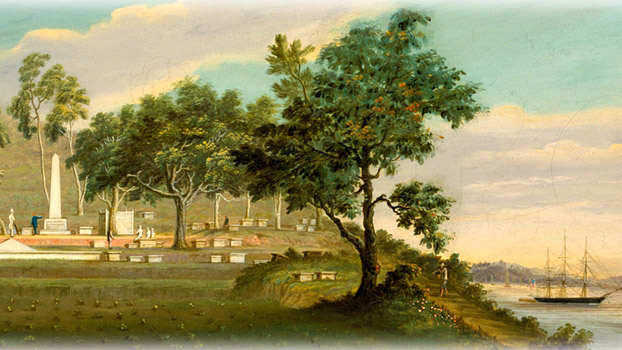 |
| |
The Christian cemetery for foreigners at Whampoa—there was also a Muslim burial ground—bore testimony to the dangers of living in south China’s extreme tropical climate. “In the height of the seasons in 1820s and 1830s, there were often as many as 100 sailing vessels lying at Whampoa for three months or more, awaiting their cargoes of tea. As each ship would have between 50 and 150 people on board, together they formed a large concentration of souls and the death rate was high...” (An East India Company Cemetery, p. 4)
“View of Foreign Cemetery on Dane's Island,” ca. 1840
by Sunqua
National Maritime Museum [cwPT_1830_morrison_ProtBu45]
|
|
| |
At each stage of the voyage up the Pearl River, as the foreigners entered more deeply into Chinese territory, they depended more heavily on officially registered Chinese navigators and merchants. Since pirates also infested the waters, Chinese patrol boats helped defend the trading ships.
Chinese and Western artists delighted in portraying the multitude of Chinese boats of all sizes that dominated life on the rivers and coasts. The riverboats, generally long with flat hulls, contained enough space to hold both cargo and families living on them. Oceangoing junks had traveled the waters of East Asia, Southeast Asia, and the Indian ocean ever since the Song dynasty in the 10th century. The colorful “flower boats” moored outside every major city provided music, wine, opium, and women to those who could afford it. Small sampans supported families engaged in a great variety of niche activities—including selling provisions and even raising ducks to sell to the merchants in and around Canton. “Crab boats,” with shallow drafts and many oarsmen, could scuttle up the small inlets and deliver opium by eluding the official patrols.
|
|
Chinese Boats
Native water life on rivers and seas
|
 |
 
Oceangoing junk
“Chinese Junks,” 1850
attributed to
George Chinnery
National Maritime Museum
[cwSP_1850_
nmm_BHC1180] |
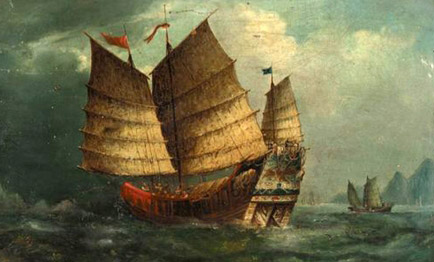 |
 |
 
River boat
Peabody Essex Museum
[cwSP_E8353221] |
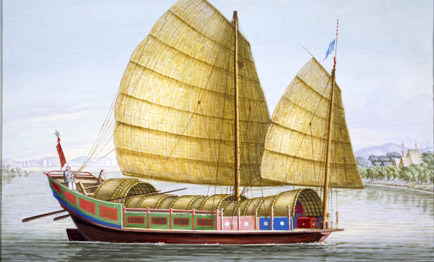 |
 |
 
“Flower Boat
With Women”
Peabody Essex Museum
[cwSP_E8354712] |
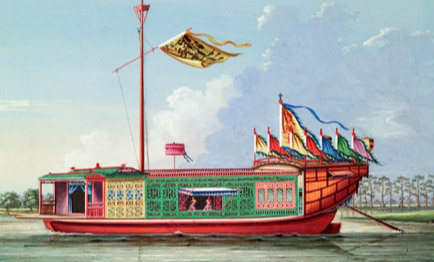 |
 |
 
“Chinese Duck Boat”
1810
by Thomas & William Daniell
National Maritime Museum [cwSP_1810
_nmm_PAD0364] |
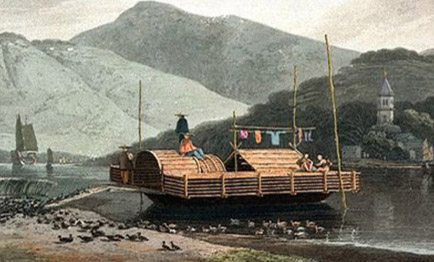 |
 |
 
Crab boat
with house boat in the background
[cwBTW_1830-50
_Whampoa] |
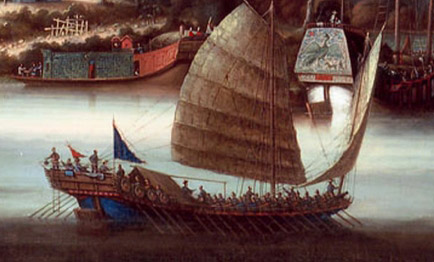 |
|
| |
The Chinese artist Youqua included an extraordinary variety of boats, buildings, and landscape details in this panoramic view of Whampoa.
“Whampoa,” ca. 1850
by Youqua
Peabody Essex Museum [cwBTW_1850c_M4478]
|
|
| |
As the traders waited impatiently at Whampoa for the Chinese boatmen to prepare their goods for shipment to and from Canton, they could observe Chinese peasants cultivating rice and raising ducks in the fields and ponds around them. Families living on sampans provided the foreigners’ daily needs. Observant foreigners at Whampoa could discover many details of Chinese life. Artists clearly portrayed the pagoda, the town along the harbor, and a fantastic array of ships.
Whampoa, as the intermediate way station between the Western colony of Macau and the Chinese city of Canton, brought Westerners in close contact with the local Chinese population. Here the two cultures met in an environment of mutual dependence.
|
|
|

